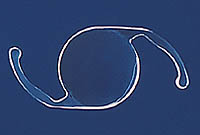Alcon receives approval to market new single-piece IOL
The bonus to the single-piece IOL proved to be highly malleable with twistable haptics. It also is tough, flexible and has good tensile strength.
ORLANDO, Fla. – After several months of clinical trials, Alcon (Fort Worth, Texas) has received approval to begin marketing their new AcrySof Single Piece IOL to clinicians across the country. The new open-loop lens design now incorporates the haptics as a part of the lens, as opposed to the conventional three-piece design.
The Food and Drug Administration approved the AcrySof Single Piece IOL on Sep. 23. It will be available for surgeons’ use in approximately February 2000, according to Alcon.
During the annual American Academy of Ophthalmology meeting here, Stephen F. Brint, MD, of the Tulane University School of Medicine, explained his perceptions of the new single-lens IOL during a presentation at the Alcon booth.
After performing roughly 75 to 80 implantations, Dr. Brint said he felt confident that the new IOL had made insertion much easier and is a very useful design.
The AcrySof Single Piece SA30 boasts a 5.5-mm diameter and measures 12.5 mm total length from haptic to haptic. The IOL has an adjustable haptic configuration and an anterior asymmetric optic. Its diopter range is from +10 D to +30 D, available in 0.5 D steps.
The single-piece IOL is seamless, with no gaps or cracks to trap cellular debris. However, the real bonus of the lens, according to Dr. Brint, is the highly malleable and twistable haptics. Because of the memory and flexibility of the AcrySof material, these haptics can be bent back on themselves, twisted and contorted to a much greater degree than multi-piece PMMA haptics. This permits the surgeon to implant the lens through small incisions much more easily than multi-piece lenses without haptic damage.
“The haptics do not permanently deform when going through a tight incision and won’t break going through the injector. Once inside, the IOL expands beautifully to conform to the bag.” Dr. Brint said.
Biocompatible material
 ---The one-piece AcrySof has a 5.5 diameter with a biconvex optic.
---The one-piece AcrySof has a 5.5 diameter with a biconvex optic.
During the Ocular Surgery News Symposium on Cataract, Refractive and Glaucoma Surgery, Dr. Brint said, “The IOL centers well and stays centered. The material is very biocompatible and has shown no capsular phimosis.” He explained that he typically uses a 3.2 mm Buratto or Caporossi forceps or a 3.5 Monarch (Alcon) injector to place the IOL in the eye. He uses the same injector cartridge for the single-piece IOL that he would use for the three-piece IOL. Typically, Dr. Brint chooses to enter the leading loop into the anterior chamber. He believes that the durable handling characteristics of the lens would allow for a variety of insertion methods.
Dr. Brint paid particular attention to the memory of the acrylic arms. He was very impressed to see that, after a few seconds, the arms, which were folded, spread out and held very tightly to the capsule walls while centering the optic with very little guidance. In his opinion, the broad arc of contact of the haptic to the bag will reduce striae and provide enhanced stability.
Dr. Brint noted that over 2 years, PCO appeared in about 7% of the patients. “Although this is still much better than the PCO rates we see with second-generation silicone and PMMA lenses, it is about double what we were used to with the multi-piece AcrySof design.” The manufacturing process used for the study lenses was different than the process for the multi-piece design, due to the need to form both the haptics and the optic out of a single piece of acrylic material. These lenses ended up with edges that were more rounded than the multi-piece design. Dr. David Apple and co-workers have determined that the square edge is one of three reasons for the multi-piece AcrySof’s low PCO rate, and that IOLs with rounded edges have much higher YAG rates; the other two reasons are lens biocompatibility and adhesion to the capsule.
According to Dr. Brint, Alcon has modified the manufacturing process of the single-piece AcrySof in order to yield a more consistent, square-edged finish. Alcon has stated that the refined single-piece IOL will feature the same square edge profile found on the AcrySof multi-piece IOL.
“By the time the lens is introduced to the market,” he told Ocular Surgery News, “I believe it will sport the same low PCO rate that we’ve come to expect.”
Dr. Brint said he was very pleased with the lens. “The lens did great with a quiet anterior capsule, no phimosis and no decentration,” he said.
Dr. Brint said that from now on, the one-piece will be his IOL of choice, but that he will keep the three-piece lenses available as a backup for cases of sulcus fixation, when a larger IOL is needed for a high myope or for IOL powers not yet available in the single-piece.
The clinical trials began 3 years ago. Although the lens is approved for general release, according to Dr. Brint, Alcon will not be releasing the new IOL until sufficient inventory is available to meet the anticipated demand for the product launch.
For Your Information:
- Stephen F. Brint, MD, can be reached at Brint Vision Correction Center, 3901 Veterans Blvd., Metairie, LA 70002; (504) 888-2020; fax: (504) 887-8166; e-mail: brintmd@aol.com. Dr. Brint has no direct financial interest in any of the products mentioned in this article, nor is he a paid consultant for any companies mentioned.
- Alcon can be reached at 6201 South Freeway, Fort Worth, TX 76134; (800) 862-5266; fax: (817) 241-0677.
